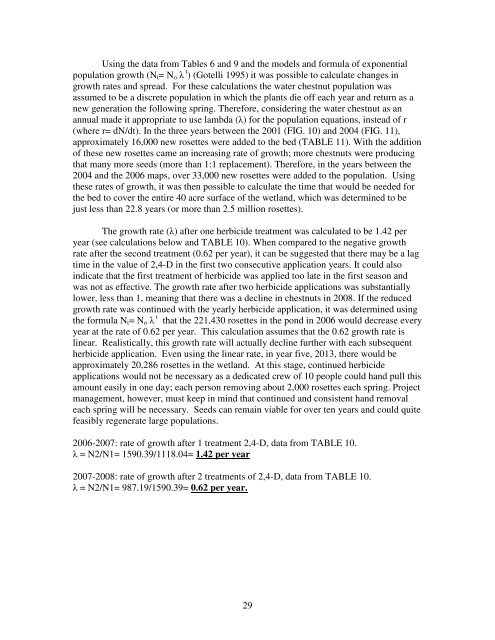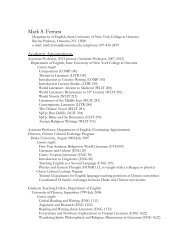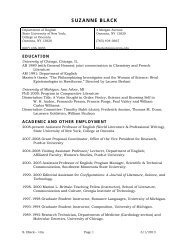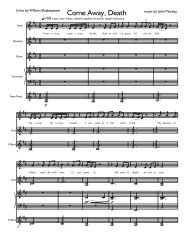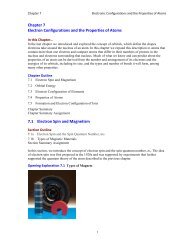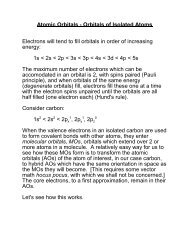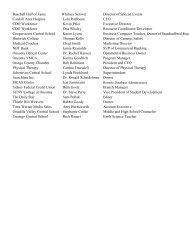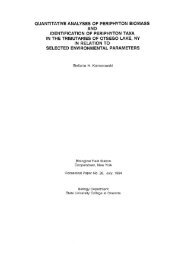Water Chestnut (Trapa natans L.) Infestation in the ... - SUNY Oneonta
Water Chestnut (Trapa natans L.) Infestation in the ... - SUNY Oneonta
Water Chestnut (Trapa natans L.) Infestation in the ... - SUNY Oneonta
Create successful ePaper yourself
Turn your PDF publications into a flip-book with our unique Google optimized e-Paper software.
Us<strong>in</strong>g <strong>the</strong> data from Tables 6 and 9 and <strong>the</strong> models and formula of exponential<br />
population growth (Nt= No t ) (Gotelli 1995) it was possible to calculate changes <strong>in</strong><br />
growth rates and spread. For <strong>the</strong>se calculations <strong>the</strong> water chestnut population was<br />
assumed to be a discrete population <strong>in</strong> which <strong>the</strong> plants die off each year and return as a<br />
new generation <strong>the</strong> follow<strong>in</strong>g spr<strong>in</strong>g. Therefore, consider<strong>in</strong>g <strong>the</strong> water chestnut as an<br />
annual made it appropriate to use lambda ( ) for <strong>the</strong> population equations, <strong>in</strong>stead of r<br />
(where r= dN/dt). In <strong>the</strong> three years between <strong>the</strong> 2001 (FIG. 10) and 2004 (FIG. 11),<br />
approximately 16,000 new rosettes were added to <strong>the</strong> bed (TABLE 11). With <strong>the</strong> addition<br />
of <strong>the</strong>se new rosettes came an <strong>in</strong>creas<strong>in</strong>g rate of growth; more chestnuts were produc<strong>in</strong>g<br />
that many more seeds (more than 1:1 replacement). Therefore, <strong>in</strong> <strong>the</strong> years between <strong>the</strong><br />
2004 and <strong>the</strong> 2006 maps, over 33,000 new rosettes were added to <strong>the</strong> population. Us<strong>in</strong>g<br />
<strong>the</strong>se rates of growth, it was <strong>the</strong>n possible to calculate <strong>the</strong> time that would be needed for<br />
<strong>the</strong> bed to cover <strong>the</strong> entire 40 acre surface of <strong>the</strong> wetland, which was determ<strong>in</strong>ed to be<br />
just less than 22.8 years (or more than 2.5 million rosettes).<br />
The growth rate ( ) after one herbicide treatment was calculated to be 1.42 per<br />
year (see calculations below and TABLE 10). When compared to <strong>the</strong> negative growth<br />
rate after <strong>the</strong> second treatment (0.62 per year), it can be suggested that <strong>the</strong>re may be a lag<br />
time <strong>in</strong> <strong>the</strong> value of 2,4-D <strong>in</strong> <strong>the</strong> first two consecutive application years. It could also<br />
<strong>in</strong>dicate that <strong>the</strong> first treatment of herbicide was applied too late <strong>in</strong> <strong>the</strong> first season and<br />
was not as effective. The growth rate after two herbicide applications was substantially<br />
lower, less than 1, mean<strong>in</strong>g that <strong>the</strong>re was a decl<strong>in</strong>e <strong>in</strong> chestnuts <strong>in</strong> 2008. If <strong>the</strong> reduced<br />
growth rate was cont<strong>in</strong>ued with <strong>the</strong> yearly herbicide application, it was determ<strong>in</strong>ed us<strong>in</strong>g<br />
<strong>the</strong> formula Nt= No t that <strong>the</strong> 221,430 rosettes <strong>in</strong> <strong>the</strong> pond <strong>in</strong> 2006 would decrease every<br />
year at <strong>the</strong> rate of 0.62 per year. This calculation assumes that <strong>the</strong> 0.62 growth rate is<br />
l<strong>in</strong>ear. Realistically, this growth rate will actually decl<strong>in</strong>e fur<strong>the</strong>r with each subsequent<br />
herbicide application. Even us<strong>in</strong>g <strong>the</strong> l<strong>in</strong>ear rate, <strong>in</strong> year five, 2013, <strong>the</strong>re would be<br />
approximately 20,286 rosettes <strong>in</strong> <strong>the</strong> wetland. At this stage, cont<strong>in</strong>ued herbicide<br />
applications would not be necessary as a dedicated crew of 10 people could hand pull this<br />
amount easily <strong>in</strong> one day; each person remov<strong>in</strong>g about 2,000 rosettes each spr<strong>in</strong>g. Project<br />
management, however, must keep <strong>in</strong> m<strong>in</strong>d that cont<strong>in</strong>ued and consistent hand removal<br />
each spr<strong>in</strong>g will be necessary. Seeds can rema<strong>in</strong> viable for over ten years and could quite<br />
feasibly regenerate large populations.<br />
2006-2007: rate of growth after 1 treatment 2,4-D, data from TABLE 10.<br />
= N2/N1= 1590.39/1118.04= 1.42 per year<br />
2007-2008: rate of growth after 2 treatments of 2,4-D, data from TABLE 10.<br />
= N2/N1= 987.19/1590.39= 0.62 per year.<br />
29


